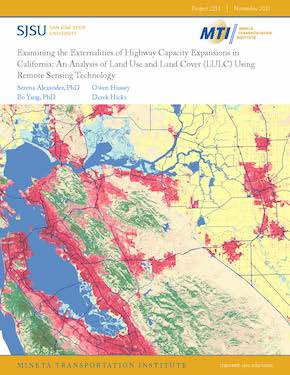- 408-924-7560
- mineta-institute@sjsu.edu
- Donate
Examining the Externalities of Highway Capacity Expansions in California: An Analysis of Land Use and Land Cover (LULC) Using Remote Sensing Technology
Highway capacity expansion has typically been proposed as a tool to alleviate traffic congestion and to mitigate harmful emissions; however, highway capacity expansion has wide impacts on land use and land cover (LULC). Cost-benefit analyses and environmental review processes for roadway capacity expansion and maintenance decisions do not comprehensively consider LULC impacts. This study examined land cover changes directly associated with highway expansion in California and the relationship between land use and the vegetation impacts of highway projects using satellite remote sensing data. The methodology involves a geospatial analysis of Normalized Difference Vegetation Index (NDVI) data in 18 sites across California before and after the highway expansion projects’ completion. We accounted for seasonality and included a set of control sites. Findings indicate that the impacts of highway expansion on changes in NDVI are diverse, stressing the importance of the environmental context around each individual project site. Sites that are located near less-developed areas with more extensive natural vegetation (e.g., sprawled areas or exurbs) show significant decline in NDVI values. Virtually all sites with insignificant changes in NDVI after highway expansion are located in areas that already exhibit heavy urban development (e.g., Los Angeles, San José) or are otherwise located near large expanses of bare, non-vegetated earth. Also, project sites that experienced multiple types of construction (i.e., adding more lanes, widening sections, bridge renovation, etc.) were more likely to exhibit decreasing NDVI values compared to project sites that only experienced one type of construction. Decisions about highway construction and capacity expansion should consider the context and the full environmental impacts, including land use and land cover changes over time.
SERENA ALEXANDER, PHD
Dr. Serena Alexander is an Associate Professor of Urban and Regional Planning and Director of Urban Online at San José State University (SJSU). Her research predominantly focuses on developing and implementing cutting-edge strategies to address climate change and the environmental impacts of transportation. In 2022, Dr. Alexander joined the U.S. Department of Transportation (USDOT) Climate Change Center (CCC) and the Office of the Under Secretary as a Visiting Scholar, where she provides leadership and research on the development of policy centered around all major transportation issues, such as infrastructure development, climate, innovation, and equity. She has published several peer-reviewed journal articles and technical reports and presented her research at national and international conferences. She has also established the American Collegiate Schools of Planning (ACSP) and Association of European Schools of Planning (AESOP) collaboration platform, focusing on climate justice and best practices of climate action planning. Dr. Alexander has worked with many multidisciplinary teams and aims at bridging the gap between technical knowledge, policy decisions, and community values. Before joining the SJSU faculty, Dr. Alexander conducted community economic development and environmental policy research at the Center for Economic Development and the Great Lakes Environmental Finance Center at Cleveland State University, where she also received her doctorate in Urban Studies (specialization in Urban Policy and Development). She holds master’s degrees in Urban and Regional Planning from California State Polytechnic University, Pomona, and Architecture from Azad University of Tehran.
BO YANG, PHD
Dr. Bo Yang is an Assistant Professor in the Department of Urban and Regional Planning at San José State University. He has an interdisciplinary education background with a B.S. in Applied Mathematics, an M.S. in Computer Science, and a Ph.D. in Geography. Dr. Yang's research interests include GIS, remote sensing, spatial statistics, UAV/drone mapping, urban heat effect, transportation impact on the urban environment, and human-environment interaction. He has published about 40 papers in peer-reviewed journals such as RSE, GRL, IJGIS, and Communications Earth & Environment. Yang’s research has been widely funded by NSF and USDOT, including NSF B2, REU, RET, and START.
OWEN HUSSEY
Owen Hussey is a Masters in Geography student at the Department of Urban and Regional Planning with a bachelor’s degree in Geology from San José State University. His research interests revolve around GIS, UAV/Drone mapping, and Remote Sensing.
DEREK HICKS
Derek Hicks is a recent graduate of San José State University’s Masters of Urban Planning program, with a bachelor’s degree in Urban and Regional Development from the University of Arizona. His research interests involve analyzing the relationship between the built and natural environment as well as climate resiliency in urban areas.
-
Contact Us
San José State University One Washington Square, San Jose, CA 95192 Phone: 408-924-7560 Email: mineta-institute@sjsu.edu






